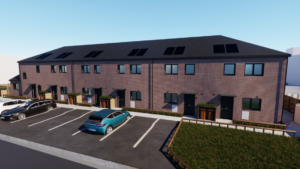Leadership Spotlight: Lee Sugden, chief executive, Salix Homes
 Lee Sugden is the chief executive of Salford-based housing association Salix Homes.
Lee Sugden is the chief executive of Salford-based housing association Salix Homes.
He spoke to NewStart about the social housing ‘stigma’, how technology can be used to support elderly residents and whether he agrees that housing associations are too focused on being developers.
Salford Council recently approved your plans to build 108 affordable homes. The council has faced criticism in recent years for the lack of affordable housing they’ve approved. Why hasn’t there been more?
Salford is growing at a tremendously fast pace, linked to MediaCity at Salford Quays and our boundary with Manchester city centre.
Unfortunately, much of that housing is private rented and very little is for affordable rent. So this scheme is important to Salford because it’s 108 apartments that will be genuinely affordable. It adds an important mix to Salford’s housing economy right in the middle of the growth bubble.
In Salford, land is at a real premium. If you own the land then you control what’s built on it.
Land within Salford is subject to competition between private developers and Section 106 agreements don’t capture as many affordable homes as one would like.
What makes Salix unique as a housing association?
We have the volume of scale (Salix manage over 8000 properties in Salford) to make a difference to communities.
In 2015 there were the Boxing Day floods. We had 300 properties that were flooded and it was devasting. One was a sheltered housing scheme which we had to evacuate, we were left wondering what to do with it.
I met the chief executive of Salford Royal and he was bemoaning that he had hundreds of vacancies for medical staff but he couldn’t attract people from abroad because the hospital didn’t have a housing offer.
We invested a couple of million pounds and we now have accommodation for doctors and nurses, so we think creatively to tackle solutions locally. We want to make the best use of assets out there.
Salix recently trialled ‘XBox’ technology to support elderly residents in their homes. What is this all about?
I started my career in the NHS and have an interest in health and housing. We’re working with Salford Royal and Salford University to see whether we can use technology to better support people to live independently and safely for longer.
A big problem for older people is falls, and the hospital all too often starts a relationship with somebody after they’ve fallen and it’s too late.
So where clinicians know somebody has a degenerative illness, we can get technology that helps track people around the house, using Xbox technology to track 27 joint points around the skeleton.
With the volume of data, you can track the health and gait of people and clinicians can use that information to spot when the optimum time for people to make changes to live in their home and make them safe.
We’ve been doing a trial with willing volunteers to help develop how that technology works. We could see a lot of new homes with this type of technology built in.
What effect has the rollout of Universal Credit had on your tenants?
Universal Credit went live in September here so we’re now seeing a lot of customers move onto that. It will take time for the full impact to be fully assessed, but what we already know is a lot of customers need support and help to migrate and work online.
We’ve set a customer hub up with technology and kit to help people use it.
We’re just starting to see people go through that first month or two, and it’s really tricky for a lot of people to adjust. With any new system, you need to give it a bit of time to bed in, but I’m very concerned about the long-term impact and whether we will have the capacity to support a significantly higher number of people all transferring at the same time.
We can support 10 a week but if that was 200 a week we wouldn’t be able to give the same support. Where would that leave those people? In a worse place, that’s for sure.
The Government released a social housing green paper earlier this year which mentioned ways of tackling the ‘stigma’ of living in social housing. Is this stigma something you find when speaking to residents?
I don’t pick that up. A lot of my customers who live here have a sense of pride in being Salfordians. I don’t hear them feeling stigmatised but in a post-Grenfell world, we need to have an open mind to these things.
A lot of TV programmes promote this stigma. It might make for great viewing but you have to be really careful. We’re half a mile from MediaCity and we get asked on a monthly basis to get involved in something and we think very carefully about it. I will not put our name to something that would do anything to engender that kind of stigma. People living in our properties don’t deserve that.
Following the Grenfell tragedy, eight of your high rise were deemed to have the dangerous ACM cladding. Why did you halt the removal of the cladding in 2017 and when will they be removed?
We’re on site now to put it right, we welcome the Government’s support to fund that work and we now have some confidence about a solution for those buildings. It’s been a fast-moving space but there’s now certainty about what’s an appropriate solution.
It doesn’t happen overnight but the programme to replace them is underway.
Are housing associations too focused on being developers and have they lost sight of their original purpose?
It’s a really difficult challenge. On the one hand, housing associations have a history of working with the more vulnerable parts of society, on the other hand, there’s a housing crisis and we all need to play a part in it.
The challenge is keeping yourself grounded in both areas and recognising we do have a role to play in ensuring the people who live in our homes have as much help and support as possible.
My job is perhaps easier than those in some large nationals because I work in one geographical area, but each organisation chooses its own way to contribute that social value through the work that it does.
We all report on it, it’s just the headlines can get distracted by the drive to build more homes. There’s no easy answer but it’s about getting that balance right.















